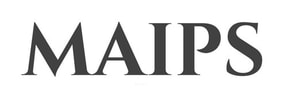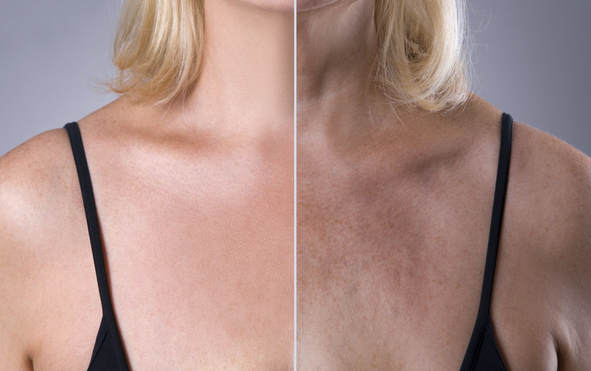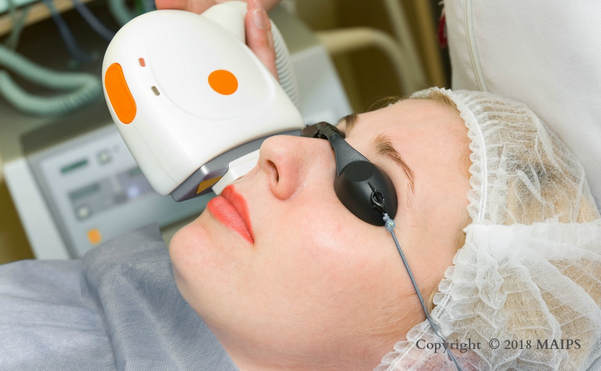IPL (Intense Pulse Light) aka Photo Facial aka Photo Rejuvenation
IPL is one of the most effective hyperpigmentation or brown spot treatments.
What exactly is IPL?
Intense Pulsed Light (IPL) are non-laser devices that can emit high-intensity light pulses at 500 to 1200 nm wavelength range, depending on the treated problem and device configuration (Goldberg DJ 2012).
An IPL treatment is a non-invasive, practically no downtime procedure for skin rejuvenation. Over 650,000 Photorejuvenation (IPL) procedures were performed in the USA in 2016, making them the 4th most popular non-invasive procedure on the country (ASAPS, 2017).
IPL can treat one of the three skin problem types -
1. Dark/brown discoloration: brown spots (also called dyschromia, age spots, sun damage, photo aged skin);
2. Vascular discoloration: capillaries and tiny veins close to the skin surface (telangiectasia), redness, rosacea;
3. Overall rejuvenations of the skin tone and texture: enlarged pores, wrinkles, uneven skin texture and tone, collagen production (Goldberg DJ, 2000; Prieto VG, 2005).
IPL treatments may be performed not only on the face, but on any other sun exposed skin areas - hands, arms, shoulders, and chest.
What exactly is IPL?
Intense Pulsed Light (IPL) are non-laser devices that can emit high-intensity light pulses at 500 to 1200 nm wavelength range, depending on the treated problem and device configuration (Goldberg DJ 2012).
An IPL treatment is a non-invasive, practically no downtime procedure for skin rejuvenation. Over 650,000 Photorejuvenation (IPL) procedures were performed in the USA in 2016, making them the 4th most popular non-invasive procedure on the country (ASAPS, 2017).
IPL can treat one of the three skin problem types -
1. Dark/brown discoloration: brown spots (also called dyschromia, age spots, sun damage, photo aged skin);
2. Vascular discoloration: capillaries and tiny veins close to the skin surface (telangiectasia), redness, rosacea;
3. Overall rejuvenations of the skin tone and texture: enlarged pores, wrinkles, uneven skin texture and tone, collagen production (Goldberg DJ, 2000; Prieto VG, 2005).
IPL treatments may be performed not only on the face, but on any other sun exposed skin areas - hands, arms, shoulders, and chest.
It is important to understand that an IPL device does not treat all these problems at once.
A specific light wavelength setting is used depending on what problem group is treated. It means that if you would like to have your face treated for the brown/sun spots, and for the vascular issues, and to have an overall rejuvenation effect, then your IPL esthetician will have to do at least three passes over the same area on the three different IPL device settings.
An IPL treatment cannot help with the age related facial volume loss and facial sagging. For example, IPL will not help with a nasolabial fold, flattening cheeks, or under-the-eye hollows.
An IPL treatment can help addressing skin aging, especially that caused by extrinsic factors such as sun damage, smoking, alcohol consumption, and other lifestyle and environmental factors.
A specific light wavelength setting is used depending on what problem group is treated. It means that if you would like to have your face treated for the brown/sun spots, and for the vascular issues, and to have an overall rejuvenation effect, then your IPL esthetician will have to do at least three passes over the same area on the three different IPL device settings.
An IPL treatment cannot help with the age related facial volume loss and facial sagging. For example, IPL will not help with a nasolabial fold, flattening cheeks, or under-the-eye hollows.
An IPL treatment can help addressing skin aging, especially that caused by extrinsic factors such as sun damage, smoking, alcohol consumption, and other lifestyle and environmental factors.


